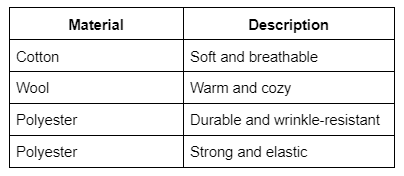What is Garment
When we talk about garments, we mean items of clothing. These are pieces of fabric made to cover our bodies. Garments come in many forms, each with a special name. For example, shirts, pants, and dresses are all different types of garments.
Types of Garments
There are many kinds of garments. They can be for different parts of the body. Some garments are for the upper body, like shirts and jackets. Others are for the lower body, like pants and skirts. Then, there are dresses and suits. These cover both the upper and lower body.
Upper Body Garments
- Shirts: They have sleeves and a collar. They can be formal or casual.
- T-shirts: They are simple and have short sleeves. They often have no collar.
- Jackets: These are worn over other clothes. They keep us warm.
Lower Body Garments
- Pants: They cover each leg separately. They are also called trousers.
- Skirts: They go around the waist. They hang down in one piece.
- Shorts: They are like pants but shorter. They are good for hot weather.
Full Body Garments
- Dresses: They cover the body in one piece. They are mostly worn by women.
- Suits: They are a set of matching clothes. Usually, a jacket and pants or a skirt.
Materials Used in Garments
Garments are made from different materials. Some are natural like cotton and wool. Others are man-made like polyester and nylon.
Choosing The Right Materials
- Fabric selection: Choosing the right fabric is crucial. It affects the garment’s look, feel, and durability. Designers must consider the fabric’s weight, stretch, and how it drapes when worn.
- Trims and embellishments: These are the details that make a garment stand out. Buttons, zippers, lace, and embroidery are selected to complement the design and enhance the garment’s overall appeal.
- Sustainability considerations: More and more, the choice of materials is also influenced by sustainability. Eco-friendly fabrics and recycled materials are becoming increasingly popular choices in the fashion industry.
Creating a garment is not just about sewing pieces of fabric together; it’s about making choices that affect the final look, feel, and impact of the piece. Each material is selected with care to ensure the garment not only looks good but also stands the test of time.
Natural Fibers In Garment Construction
The touch of cotton, the warmth of wool, the luxury of silk—natural fibers have clothed humanity for centuries. These fibers are prized for their comfort, breathability, and sustainability. They form the cornerstone of garment construction, offering wearers a connection to the natural world.
Synthetic Fibers: Revolutionizing Modern Apparel
Polyester: A synthetic fiber known for its durability, wrinkle resistance, and ability to hold color well. It’s a common choice for everyday wear due to its low cost and maintenance.
Nylon: Celebrated for its exceptional strength and elasticity. Garments made from nylon are typically lightweight and quick-drying, making it a favorite for activewear and hosiery.
Acrylic: Often used as a wool substitute, acrylic is soft, warm, and can be machine-washed, which is why you’ll find it in many winter garments like sweaters and beanies.
Blended Fabrics: Combining The Best Of Both Worlds
Blended fabrics are a testament to human ingenuity, where the strengths of different materials come together to create garments that are both functional and fashionable. Imagine the comfort of cotton with the wrinkle resistance of polyester, or the luster of silk with the durability of nylon.
Eco-friendly Materials: The Future Of Fashion
Organic Cotton: Unlike traditional cotton, organic cotton is grown without harmful pesticides or synthetic fertilizers. It’s kinder to the environment and safer for the farmers who cultivate it.
Bamboo: This fast-growing plant is turned into a fiber that’s naturally antibacterial, moisture-wicking, and soft to the touch. It’s an excellent choice for eco-conscious consumers.
Recycled Fabrics: From plastic bottles to old garments, recycling materials to create new clothing reduces waste and conserves resources. These fabrics are a step towards a more sustainable fashion industry.
How Garments Are Made
Garments are made in many steps. First, designers make a plan. They decide what it will look like. Then, they choose the fabric. After that, patterns are made. These are like guides. They show where to cut the fabric.
Next, the fabric is cut. It is sewn together. This forms the garment. Sometimes, extra things are added. Like buttons or zippers. Finally, the garment is checked. It must be perfect before we can wear it.
Choosing the Right Garment
When picking a garment, think about a few things. What is the occasion? Is it for every day or a special event? Also, consider the weather. Do you need something warm or cool? And don’t forget about your style. Wear what makes you feel good!
Tips For Choosing Garments:
- Look for the right size. It should fit you well.
- Pick a color you like. It should match your other clothes.
- Think about care. Can you wash it easily?
Job In Garment Industry
A garment industry job encompasses roles from designing and manufacturing to marketing apparel. Careers in this sector demand creativity, precision, and an understanding of fashion trends, offering dynamic opportunities for professionals passionate about clothing and textiles.
Let’s unravel some of the key roles that form the backbone of the garment industry.
- Fashion Designer
- Pattern Maker
- Quality Control
- Quality Assurance
- Industrial Engineering
- Garments Planning
- Garment Technologist
- Marketing And Sales
- Production Manager
The garment industry is a bustling hive of activity, offering a plethora of job opportunities that cater to a wide range of skill sets and interests. From creative design to meticulous quality control, this sector requires a diverse workforce to keep the wheels of fashion turning.
Conclusion
Garments go beyond their basic function of covering our bodies. They embody cultural significance, fashion trends, and personal expression. Choosing the right pieces can elevate your style and confidence. As we’ve explored, the garment industry is vast and ever-evolving, offering endless possibilities for consumers and creators alike.
Let’s continue to weave creativity and sustainability into our wardrobe choices. The future of garments is not just about what we wear, but how it reflects our identity and values in an ever-changing world.
Also Read:
What is The Main Difference Between Apparel and Garment?
What is Denim Fabric: Different Types of Denim Fabric
What Is Knit Fabric: Different Types of Knit Fabric
What Is Woven Fabric: Different Types of Woven Fabric
How Many Types of Garments: 8 Tips On Choosing Right Garment
Frequently Asked Questions
What Is Garment?
A garment is any piece of clothing that is worn on the body. It can range from simple articles like shirts and trousers to complex designs like dresses and suits.
How Are Garments Produced?
Garments are produced through a process that includes design, pattern making, cutting fabric, sewing, and finishing. This process can be done by hand or with machines and may involve different textile techniques depending on the garment type.
What Materials Are Used For Garments?
Garments can be made from a wide range of materials including natural fibers like cotton, wool, silk, and linen, as well as synthetic fibers like polyester, nylon, and spandex. The choice of material often depends on the garment’s intended use and desired qualities.
Can Garments Be Recycled?
Yes, garments can be recycled. Old or unwanted clothing can be repurposed into new items, such as cleaning rags or insulation material. Some fabrics can also be broken down and re-spun into new fibers for making fresh garments.





